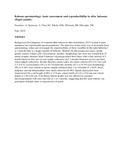| dc.contributor.author | Nyachieo, A | |
| dc.contributor.author | Spiessens, C | |
| dc.contributor.author | Chai, DC | |
| dc.contributor.author | Kiulia, NM, | |
| dc.contributor.author | Mwenda, JM | |
| dc.contributor.author | D'hooghe, TM | |
| dc.date.accessioned | 2013-07-09T11:54:51Z | |
| dc.date.available | 2013-07-09T11:54:51Z | |
| dc.date.issued | 2012 | |
| dc.identifier.citation | Nyachieo A, Spiessens C, Chai Dc, Kiulia Nm, Mwenda Jm, D'hooghe Tm. Baboon Spermatology: Basic Assessment And Reproducibility In Olive Baboons (papio Anubis).. Vol. 41.; 2012. J. Med. Primatol. 41(5). | en |
| dc.identifier.uri | http://onlinelibrary.wiley.com/doi/10.1111/j.1600-0684.2012.00555.x/abstract?deniedAccessCustomisedMessage=&userIsAuthenticated=false | |
| dc.identifier.uri | http://erepository.uonbi.ac.ke:8080/xmlui/handle/123456789/46721 | |
| dc.description.abstract | Background
Development of a reproducible baboon in vitro fertilization (IVF) system require optimized and reproducible sperm parameters. The objective of this study was to document basic spermatology values and investigate the reproducibility of these variables in the same baboons 1 or 3 months later in a larger number of baboons.
Methods
In this prospective study, sperm quality (semen volume, pH, concentration, motility, morphology and size) was evaluated in 27 sperm samples obtained from 9 baboons electroejaculated three times with a time interval of 1 month (between first and second sample collection) and 3 months (between second and third round sample collection).
Results
Baseline sperm values for semen volume (0.5 ± 0.3 ml), pH (7.5 ± 0.3), concentration (54.2 ± 19.3 million/ml), motility (67.3 ± 18.5%) and morphology (89.2 ± 4.8%) were similar to sperm samples obtained after 1 or 3 months (P > 0.05). Head, midpiece and tail abnormalities were rarely observed (0–9%). Sperm dimensions were characterized by a tail length of 69.6 ± 13.9 μm, a head width of 2.41 ± 0.43 μm and a head length of 3.49 ± 0.6 μm.
Conclusion
Sperm quality was not affected by repeated electroejaculation with time intervals of 1 or 3 months, suggesting that the same baboon can participate multiple times in reproductive research. | en |
| dc.language.iso | en | en |
| dc.publisher | University of Nairobi, | en |
| dc.subject | baboon | en |
| dc.subject | morphology | en |
| dc.subject | motility | en |
| dc.subject | pH | en |
| dc.subject | sperm | en |
| dc.subject | sperm concentration | en |
| dc.title | Baboon spermatology: basic assessment and reproducibility in olive baboons (Papio anubis) | en |
| dc.type | Article | en |
| local.publisher | College of Health Sciences, | en |

